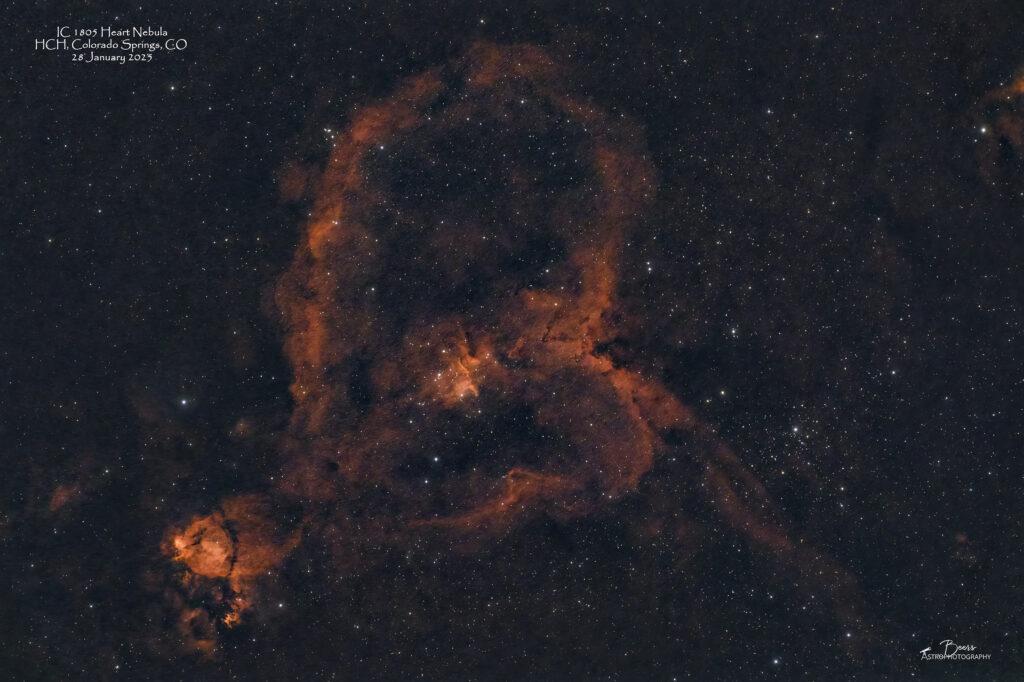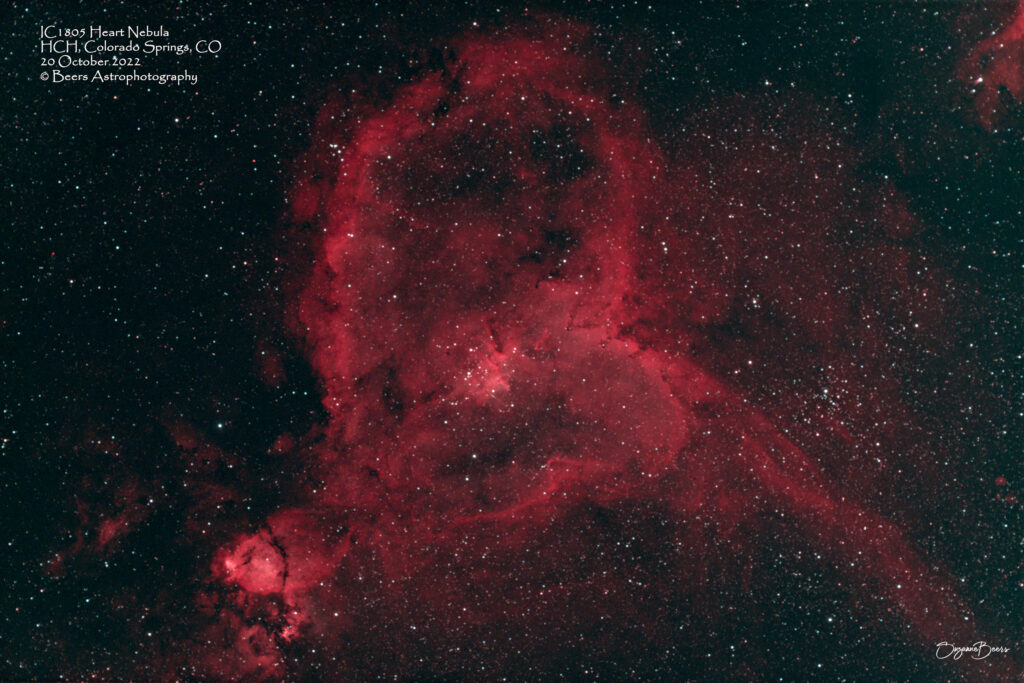
Fun facts
IC1805 Heart Nebula (also known as the Running dog nebula) is an emission nebula, 7500 light years away from Earth and located in the Perseus Arm of the Galaxy in the constellation Cassiopeia. It was discovered by William Herschel on 3 November 1787. It displays glowing ionized hydrogen gas and darker dust lanes. The brightest part of the nebula (a knot at its western edge) is separately classified as NGC 896 Fishhead Nebula, because it was the first part of the nebula to be discovered.
The nebula’s intense red output and its morphology are driven by the radiation emanating from a small group of stars near the nebula’s center. This open cluster of stars, known as Collinder 26 or Melotte 15, contains a few bright stars nearly 50 times the mass of the Sun, and many more dim stars that are only a fraction of the Sun’s mass.
The Heart Nebula is also made up of ionized oxygen and sulfur gasses, responsible for the rich blue and orange colors seen in narrowband images. The shape of the nebula is driven by stellar winds from the hot stars in its core. The nebula also spans almost 2 degrees in the sky, covering an area four times that of the diameter of the full moon.
Other Catalog Designations: NGC 896, IC1805, Sh2-190
Subtype: Emission Nebula
Apparent dimensions: 150’ x 150’
Distance from Earth: 7500 light years
Visual Magnitude: 6.5
Radius: 165 light years
Constellation: Cassiopeia
{from: https://en.wikipedia.org/wiki/Heart_Nebula }
Capture Notes
During our dark skies trip to the Kiowa National Grasslands over the New Years Eve weekend, it occurred to me that it would be great to be able to stay inside the Beast to control and check on the equipment without having to go outside into the elements. A ZWO ASIAIR-like set-up (https://www.zwoastro.com/product-category/asiair/) without their proprietary solution would be ideal. I mentioned the idea to Paul on the drive home.
Being the problem-solver that he is, Paul jumped right on the latest BeersAP “I need” or “it would be great if I had” challenge… He designed and fabricated a transmitter/receiver set-up with a 50-foot length of Cat 6 cabling running between them, that I am nicknaming the “Baye-Aire.” I used the completed Baye-Aire product to image during the January New Moon nights from the front patio, to test it out before we took it to the field on a dark skies trip.
This image of IC1805 Heart Nebula captured on 28Jan2025 represents “first light” (actually second “first light” with the Baye-Aire. Everything worked perfectly. If you are interested, check out the blog (link to be inserted once it is completed) for a full description of the Baye-Aire equipment and operations.
As an aside, I have moved this gallery’s previously featured image of IC1805 to the “other images” section below…not because I think this image is better – just because it is newer. (I have a slight preference for the October 2022 image captured with the Canon EOS-Ra on the Southern Cross, using an Optolong LeXtreme light pollution filter to this one captured with the ZWO ASI2400MC on the Southern Cross, using an Optolong LPro light pollution filter.)
Equipment
All equipment controlled by HP Probook (DSO-CTRL1) running Sequence Generator Pro v4.4.1.1441.
- Imaging (ASI2400-SC-LPro): ZWO ASI2400MC imaging camera with Optolong L-Pro LP filter; (Southern Cross) Askar FRA600 108mm f/5.6 Quintuplet Petzval Flat-Field Astrograph
- Mount: Rainbow Astro RST-135E (controlled by iHubo ASCOM driver)
- Polar alignment: QHYCCD camera (controlled by Polemaster for polar alignment)
- Autoguiding: Orion 60mm Multi-Use Guide Scope with Orion StarShoot AutoGuider Pro Mono Astrophotography Camera (controlled by PHD2)
- Remote connection: (Baye-Aire) AV Access U2EX50 USB2.0 Extender 60m Receiver/Transmitter connected with 50’ Cat 6 communication cable
- Imaging (ASI2400-SC-LPro): ZWO ASI2400MC imaging camera with Optolong L-Pro LP filter; (Southern Cross) Askar FRA600 108mm f/5.6 Quintuplet Petzval Flat-Field Astrograph
- Remote connection: (Baye-Aire) AV Access U2EX50 USB2.0 Extender 60m Receiver/Transmitter connected with 50’ Cat 6 communication cable
- Mount: Rainbow Astro RST-135E (controlled by iHubo ASCOM driver)
- Polar alignment: QHYCCD camera (controlled by Polemaster for polar alignment)
- Autoguiding: Orion 60mm Multi-Use Guide Scope with Orion StarShoot AutoGuider Pro Mono Astrophotography Camera (controlled by PHD2)
Capture & processing notes
Sequence plan: Gain 158, Offset 30, Temp 0°C; 66x5min. Captured 27Jan2025, 19:17MST – 28Jan2025, 02:23MST. Total exposure time: 5:30hrs.
Imaging Equipment: ZWO ASI2400MC with Optolong LPro on Askar FRA600
Capture: 25 January 2025
Shooting location: HCH, Colorado Springs, Colorado
Processing: Captured with SGP, stacked in APP, star removal with Starnet++, processing with PS/LR.
Other images of IC1805 Heart Nebula

Capture Notes
Based upon Ann Chavtur’s suggestion, that she uses the LeXtreme filter whenever she is shooting from her house, I decided to reimage the Heart Nebula (I’ve imaged this target with several other imaging stream configurations (RaBB mosaics, LPro filter) with the new RaSC using the LeXtreme filter. Spending the entire night on the single target
Equipment
Polar alignment: QHYCCD camera (controlled by Polemaster)
Imaging stream: Askar FRA600, Canon EOS Ra with Optolong LeXtreme light pollution filter
Mount: Rainbow Astro RC-135E (controlled by iHubo)
Autoguider: Orion 60mm Multi-Use Guide Scope, Orion StarShoot AutoGuider Pro Mono Astrophotography Camera (controlled by PHD2)
All equipment controlled by HP Probook running Sequence Generator Pro v3.2.0.660.
Capture & processing notes
Sequence plan: ISO1600, 90x300sec; Total=7:30hrs. Captured 20Oct 2022, 1952MDT – 21Oct2022, 0417MDT.
Imaging Equipment: Canon EOS Ra, Optolong LeX on Askar FRA600
Capture: 20 October 2022
Shooting location: HCH, Colorado Springs, Colorado
Processing: Stacked in APP, using Ha-OIII Color for stacking algorithm, due to LeX LP filter.
